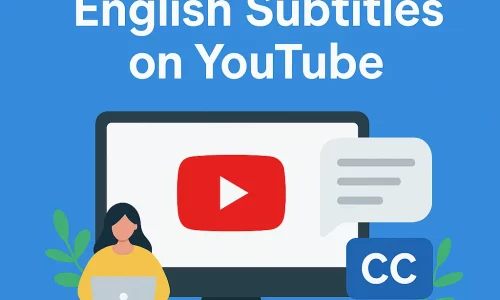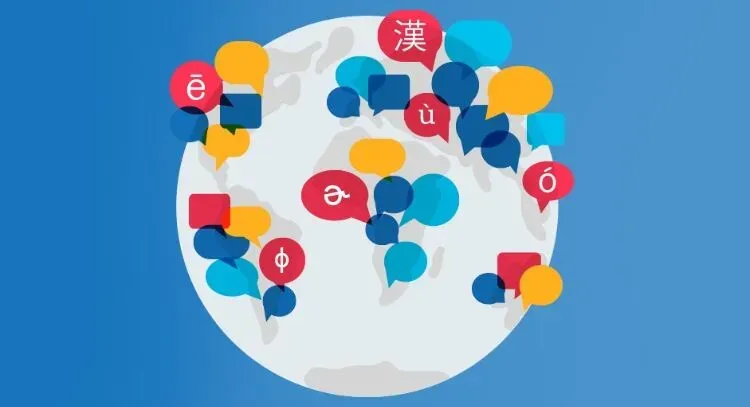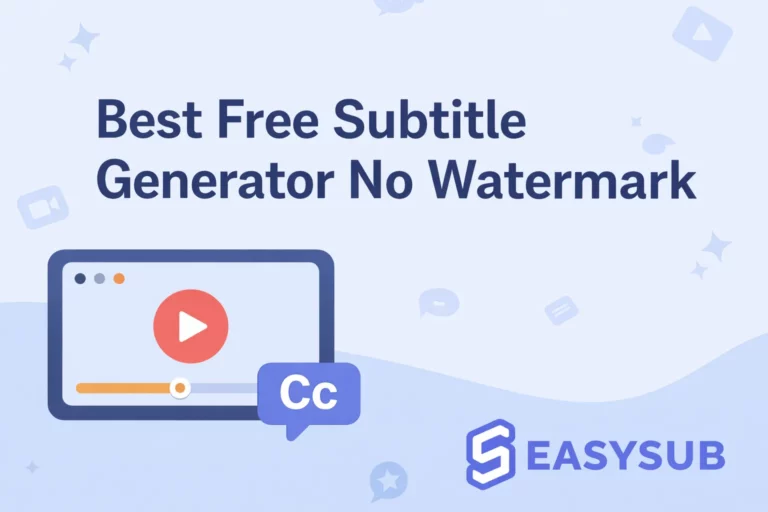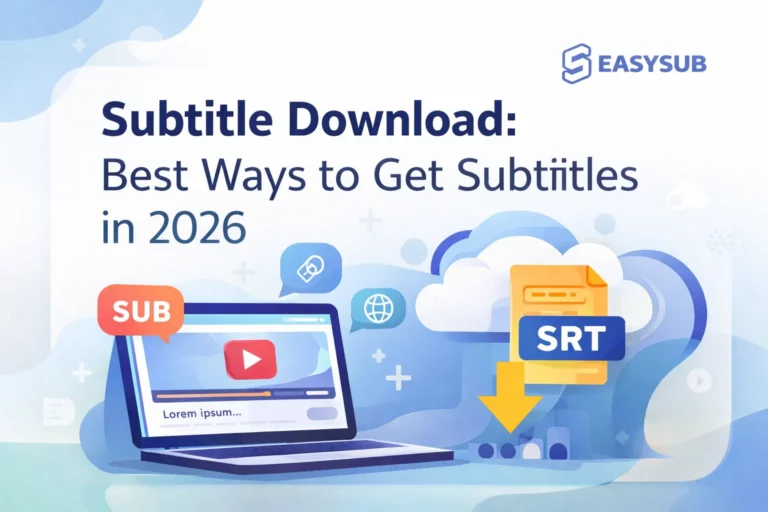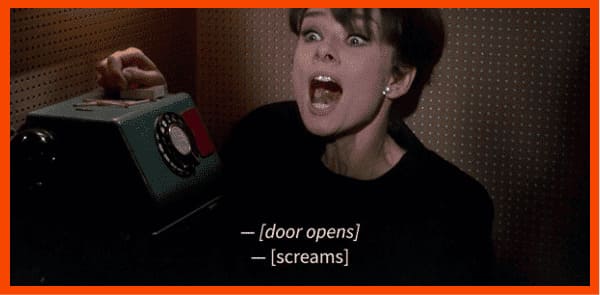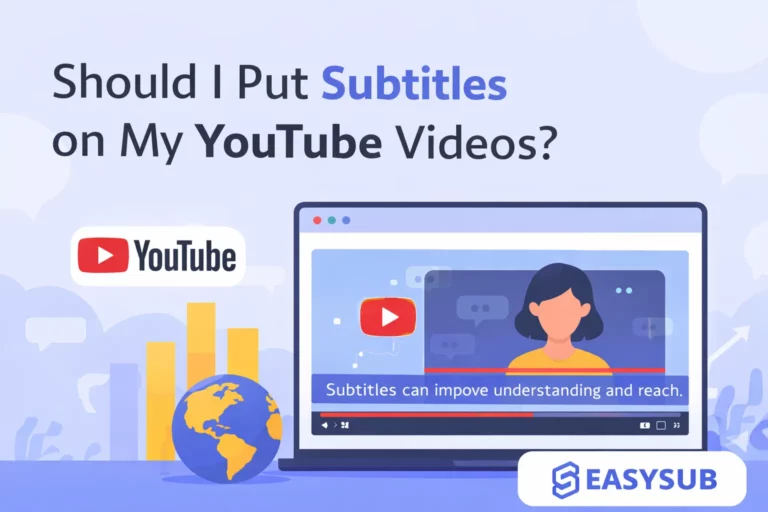في إنشاء الفيديو،, كيفية إنشاء ترجمات باللغة الإنجليزية على YouTubeالترجمة ليست أداةً أساسيةً لتحسين إمكانية الوصول فحسب، بل تُساعد المشاهدين أيضًا على فهم المحتوى في البيئات الصامتة. علاوةً على ذلك، تُحسّن بشكل ملحوظ أداء الفيديو في محركات البحث. تُظهر الأبحاث أن الفيديوهات المصاحبة للترجمة أكثر عرضةً للفهرسة في محركات البحث، مما يزيد من ظهورها ومشاهداتها. بالنسبة للمبدعين الذين يسعون للوصول إلى جمهور عالمي، تُعدّ الترجمة الإنجليزية أمرًا لا غنى عنه تقريبًا.
مع ذلك، لا يدرك جميع المستخدمين كيفية إنشاء ترجمات إنجليزية بكفاءة على يوتيوب. على الرغم من أن يوتيوب يوفر ميزة الترجمة التلقائية، إلا أن دقتها وقابليتها للتعديل وإمكانية تصديرها محدودة. بناءً على الحالة، يتعين على المبدعين الاختيار بين الخيار المجاني وأدوات الترجمة الاحترافية. ستحلل هذه المقالة إيجابيات وسلبيات وظائف يوتيوب المدمجة من منظور احترافي، وتشرح كيفية استخدام أدوات احترافية مثل Easysub لإنشاء وإدارة الترجمات الإنجليزية بسرعة ودقة أكبر.
جدول المحتويات
ما هي ترجمات اليوتيوب؟
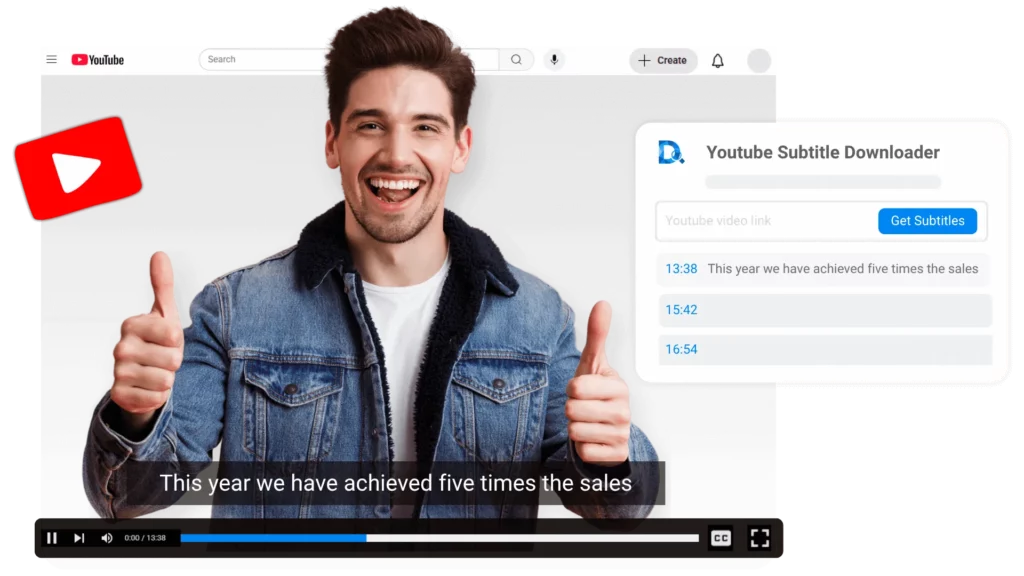
تُعد ترجمات يوتيوب ميزةً مهمةً تُساعد المشاهدين على فهم محتوى الفيديو بشكل أفضل. هناك نوعان رئيسيان منها:
- الترجمة التلقائيةيستخدم يوتيوب تقنية التعرف التلقائي على الكلام (ASR) لإنشاء ترجمات تلقائيًا. يمكن للمستخدمين تفعيلها مباشرةً بعد تحميل مقاطع الفيديو.
- التحميل اليدوي:يمكن للمبدعين تحميل ملفات التعليقات التوضيحية الخاصة بهم (مثل SRT وVTT) لضمان الدقة والتنسيق الموحد.
ال قيمة الترجمة "يتجاوز ذلك بكثير"“عرض النص“". إنه مرتبط بشكل مباشر بـ:
- إمكانية الوصول:يتيح للأشخاص الذين يعانون من ضعف السمع أو المستخدمين في البيئات الصامتة الوصول إلى المعلومات أيضًا.
- ميزة تحسين محركات البحث:تساعد الترجمات، كمحتوى نصي، محركات البحث على فهم محتوى الفيديو، وبالتالي تحسين ترتيب الفيديو على Google وYouTube.
- الاحتفاظ بالجمهور:تشير البيانات إلى أن مقاطع الفيديو التي تحتوي على ترجمة تكون أكثر احتمالية للمشاهدة بالكامل، مما يقلل بشكل فعال من معدلات الارتداد.
- الوصول العالميالترجمة الإنجليزية مناسبةٌ بشكلٍ خاصٍّ للتعليم والتسويق العابر للحدود والتواصل الدولي. فهي تُساعد المبدعين على تجاوز حواجز اللغة والوصول إلى جمهورٍ أوسع.
لا تعد ترجمات YouTube مجرد وظيفة مساعدة فحسب، بل إنها أيضًا أداة أساسية لتعزيز الوصول ومعدلات التحويل وتأثير العلامة التجارية.
دليل خطوة بخطوة: كيفية إنشاء ترجمات باللغة الإنجليزية على YouTube
يُركز هذا القسم على الوظائف المُدمجة في استوديو يوتيوب، مُقدمًا عمليةً مباشرةً وعمليةً لإنشاء ترجمات باللغة الإنجليزية، بالإضافة إلى معايير الجودة وحلول المشكلات الشائعة. العملية بأكملها مُختصرة لتسهيل التنفيذ والمراجعة.
العمل التحضيري (تحسين معدل النجاح والدقة)
- التسجيل واضح. تجنب ضجيج الرياح والصدى.
- في قسم "التفاصيل ← اللغة"، اضبط لغة الفيديو على "الإنجليزية". هذا يُمكّن النظام من التعرّف عليها.
- استخدم مصطلحات متسقة. حضّر قائمة بالأسماء/العلامات التجارية مسبقًا، لتتمكن من إجراء البحث والاستبدال بشكل أسرع لاحقًا.
الخطوة 1 | تسجيل الدخول واختيار الفيلم
- يفتح استوديو يوتيوب.
- اذهب الى محتوى.
- حدد الفيديو الذي تريد إضافة الترجمة إليه.
الخطوة 2 | ادخل إلى لوحة الترجمة
- انقر على ترجمات على الجانب الأيسر.
- إذا لم يتم عرض أي لغة، انقر فوق إضافة لغة → الإنجليزية.
- انتظر حتى يقوم النظام بإنشاء الإنجليزية (تلقائي) المسار (تختلف المدة حسب طول الفيديو وطابور الخادم، وتتراوح من بضع دقائق إلى أكثر من عشر دقائق).
.webp)
الخطوة 3 | إنشاء وتحرير الترجمة التلقائية
.webp)
- تحديد الموقع الإنجليزية (تلقائي) في قائمة الترجمة.
- انقر للدخول والاختيار تعديل / تكرار وتحرير (قد تعرض الواجهة أحد هذه الخيارات).
- قم بإجراء المراجعات اللازمة: التهجئة، الأسماء الصحيحة، علامات الترقيم، استخدام الأحرف الكبيرة.
- قم بمراجعة الجدول الزمني: قم بدمج الجمل أو تقسيمها لجعل المعنى واضحًا وجعل فواصل الأسطر مناسبة.
المواصفات العملية (لتسهيل الفهم السريع للقراء):
- يتكون كل عنوان فرعي من 1-2 سطر.
- يجب ألا يتجاوز كل سطر 42 حرفًا (يوصى بأن لا يتجاوز الإصدار الإنجليزي 37 حرفًا).
- يتم عرض كل عنوان فرعي لمدة تتراوح من 2 إلى 7 ثواني.
- لا ينبغي أن تزيد سرعة القراءة عن 17-20 حرفًا في الثانية.
- ينبغي وضع الكلمات المهمة في نهاية السطر أو بدايته لتجنب انقطاع الكلمات.
الخطوة 4 | الإصدار والمراجعة
- انقر على نشر.
- العودة إلى صفحة التشغيل، وتمكين نسخة, ، ومراجعة كل جزء على حدة.
- إذا تم العثور على أي سهو، ارجع إلى ترجمات لوحة واستمر في تعديل.
قائمة التحقق من الجودة (يجب التحقق منها مرة واحدة على الأقل):
- هل أسماء الأشخاص والأماكن والعلامات التجارية متسقة؟
- هل الأرقام والوحدات والأسماء الصحيحة صحيحة؟
- هل الكلمات الحشوية (أوه/أم) غير ضرورية للحذف؟
- هل علامات الترقيم والأحرف الكبيرة متوافقة مع قواعد الكتابة باللغة الإنجليزية؟
الخطوة 5 (اختياري) | تحميل ملف SRT يدويًا
إذا كنت قد انتهيت بالفعل من الترجمة، أو إذا كنت تريد تحسينها محليًا قبل تحميلها جميعًا مرة واحدة:
- اذهب الى الترجمة → إضافة لغة (الإنجليزية).
- يختار تحميل الملف → مع التوقيت (مع رمز الوقت) أو بدون توقيت (بدون رمز زمني).
- اختر .srt/.vtt ملف للتحميل والحفظ.
استكشاف الأخطاء وإصلاحها
- غير قادر على اكتشاف اللغة الإنجليزية (تلقائيًا):تأكد من ضبط لغة الفيديو على إنجليزي; انتظر حتى تكتمل المعالجة؛ تحقق مما إذا كان هذا مقطع فيديو تم تحميله حديثًا وما زال في مرحلة التحويل.
- انحراف الخط الزمني الفقرات الطويلة عرضة للانحراف. قسّم الجمل الطويلة إلى جمل أقصر؛ قلّل الحوارات المتداخلة؛ وإذا لزم الأمر، اضبط وقتي البداية والنهاية يدويًا.
- أخطاء التعرف المتكررة على الأسماء الصحيحة :أولاً، قم باستبدالها بشكل موحد في القاموس المحلي؛ ثم قم بتحميل الترجمات الكاملة أو استخدم Easysub لاستبدال الدفعة.
- هل تريد استخدام الترجمة عبر المنصات؟ :الترجمات التلقائية في يوتيوب مخصصة للاستخدام الداخلي في الغالب. إذا SRT/VTT إذا كان ذلك ضروريًا، فمن المستحسن استخدام Easysub لتصدير الملف القياسي ثم تحميله إلى منصات مختلفة.
حدود الترجمة المولدة تلقائيًا في YouTube
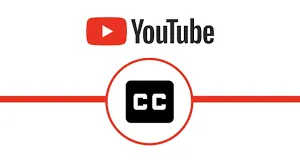
على الرغم من أن ميزة الترجمة التلقائية في يوتيوب تُقدم راحةً كبيرةً لمنشئي المحتوى، إلا أنها لا تزال تعاني من بعض القيود التي لا يُمكن تجاهلها. غالبًا ما تؤثر هذه القيود بشكل مباشر على احترافية وكفاءة الترجمة.
دقة محدودة
تعتمد ترجمات يوتيوب التلقائية على تقنية التعرف على الكلام (ASR)، وتعتمد دقة هذه الترجمات بشكل كبير على جودة صوت الفيديو. قد تؤدي عوامل مثل اختلاف اللهجات، وضوضاء الخلفية، والمحادثات المتزامنة بين عدة أشخاص، وسرعات التحدث العالية جدًا إلى أخطاء في الترجمة.
للاستخدام على المنصة فقط
عادةً ما تُعرض التسميات التوضيحية التلقائية على يوتيوب داخل المنصة فقط. لا يمكن للمستخدمين تصدير ملفات التنسيقات القياسية مباشرةً (مثل SRT وVTT)، مما يعني أنه لا يمكن إعادة استخدامها على منصات فيديو أخرى أو في مشغلات محلية. إذا احتاج منشئو المحتوى إلى توزيع الفيديو نفسه على TikTok أو Vimeo أو أنظمة إدارة التعلم المؤسسية، فعليهم الاعتماد على أدوات خارجية للمعالجة الثانوية.
قدرات تعدد اللغات غير كافية
تستهدف ترجمات يوتيوب التلقائية اللغات الشائعة (مثل الإنجليزية والإسبانية)، كما أن دعمها للغات الأقليات أو الترجمات متعددة اللغات محدود. علاوة على ذلك، لا يوفر وظيفة الترجمة الآلية. إذا كان المبدعون بحاجة إلى ترجمات متعددة اللغات لسوق عالمية، فإن الاعتماد فقط على ميزات المنصة ليس كافياً على الإطلاق.
كفاءة التحرير منخفضة
غالبًا ما تتطلب الترجمات التي يُنتجها النظام تدقيقًا يدويًا مكثفًا. وخاصةً في الفيديوهات الطويلة، فإن مهمة تصحيح الإملاء وعلامات الترقيم وضبط التسلسل الزمني جملةً بجملة تتطلب جهدًا كبيرًا. أما بالنسبة للمؤسسات التعليمية أو فرق إنتاج المحتوى، فسيتطلب ذلك وقتًا وجهدًا إضافيين.
تُعد التسميات التوضيحية التلقائية في يوتيوب مناسبة للمبتدئين أو لإنشاء مسودات تسميات توضيحية بسرعة. ومع ذلك، إذا كان الهدف هو دقة عالية ودعم متعدد اللغات والتوافق بين الأنظمة الأساسية, الاعتماد عليها وحدها لا يكفي. في هذه المرحلة، يُمكن معالجة هذه المشكلات بفعالية من خلال دمجها مع أدوات احترافية (مثل Easysub)، مما يوفر وقت المُنشئين ويُحسّن جودة الترجمة.
الحل الاحترافي: Easysub لمنشئي المحتوى على YouTube
بالنسبة لمنشئي المحتوى الذين يسعون إلى جذب المزيد من المشاهدين وتعزيز احترافيتهم على يوتيوب، غالبًا ما يكون الاعتماد على ميزة الترجمة التلقائية للمنصة غير كافٍ. يقدم Easysub حلاً شاملاً للترجمة الاحترافية، مما يساعد المستخدمين على تجاوز قيود وظائف يوتيوب المدمجة وتحقيق إنشاء وإدارة ترجمة أكثر كفاءة ودقة.
المزايا الأساسية لـ Easysub
- التعرف عالي الدقة
يعتمد Easysub على نماذج متقدمة للتعرف على الكلام، ويمكنه الحفاظ على دقة عالية في البيئات متعددة اللهجات والصاخبة. سواءً كانت المصطلحات المهنية في الفيديوهات التعليمية أو العلامات التجارية في إعلانات التجارة الإلكترونية العابرة للحدود، يمكن الحصول على نتائج نسخ أكثر دقة. هذا يُقلل بشكل كبير من الوقت اللازم للتدقيق اليدوي.
- التصدير بنقرة واحدة (SRT/VTT/ASS)
يدعم Easysub تصدير تنسيقات الترجمة الشائعة بنقرة واحدة (SRT, ، VTT، ASS)، ويمكن تطبيق هذه الملفات مباشرة على أنظمة VLC وQuickTime وLMS أو تم إعادة تحميلها إلى تيك توك, فيميو ومنصات أخرى. بخلاف الترجمة التلقائية في يوتيوب، يتمتع المستخدمون بالتحكم الكامل في الملفات، وتضمن الترجمة استخدامًا متعدد المنصات. - معالجة الدفعات وتعزيز الكفاءة
بالنسبة للمؤسسات التعليمية أو فرق المحتوى، يُعدّ التعامل مع عدة مقاطع فيديو في آنٍ واحد أمرًا ضروريًا. يوفر Easysub إمكانية التحميل الجماعي وإنشاء المحتوى تلقائيًا، بالإضافة إلى ميزات التعاون بين الفرق وإدارة الإصدارات، مما يُقلل بشكل كبير من تكلفة العمليات المتكررة.
سيناريوهات الاستخدام النموذجية
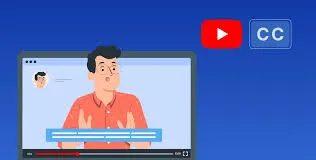
- منشئ محتوى على يوتيوب
على يوتيوب، عند إنشاء ترجمات باللغة الإنجليزية، غالبًا ما يرغب منشئو المحتوى في توزيع المحتوى على منصات أخرى. يُمكّن Easysub المستخدمين من تصدير ملفات الترجمة بسرعة وإعادة استخدامها، مما يُجنّبهم العمل المُكرر.
- مؤسسة تعليمية
تتطلب المدارس ومنصات التدريب الإلكترونية ترجمات لتلبية متطلبات إمكانية الوصول (مثل معايير WCAG). يوفر Easysub ترجمات موحدة متعددة اللغات لضمان سهولة استخدام المحتوى عبر مختلف أنظمة التدريس. - فريق التسويق المؤسسي
تحتاج الشركات إلى ترويج محتوى الفيديو في مختلف البلدان والمناطق. تُسهّل وظيفة الترجمة متعددة اللغات في Easysub الوصول إلى جمهور عالمي بسرعة، مما يُحسّن معدل التحويل وكفاءة نشر فيديوهات التسويق.
النهج المجاني مقابل النهج الاحترافي
| البعد | خيار مجاني (ترجمات يوتيوب التلقائية) | الخيار الاحترافي (Easysub) |
|---|---|---|
| يكلف | حر | مدفوع (مع توفر نسخة تجريبية مجانية) |
| دقة | معتدل، متأثر بشدة باللهجات/الضوضاء | دقة عالية، مستقرة عبر سيناريوهات متعددة |
| القدرة على التصدير | لا يمكن التصدير، يقتصر على استخدام المنصة فقط | تصدير بنقرة واحدة إلى SRT/VTT/ASS، متوافق مع مختلف الأنظمة الأساسية |
| دعم متعدد اللغات | يقتصر على اللغات الشائعة، ولا توجد ميزة الترجمة | يدعم إنشاء الترجمة والترجمة متعددة اللغات |
| كفاءة | مناسب لمقاطع الفيديو القصيرة، بينما تتطلب مقاطع الفيديو الطويلة تحريرًا يدويًا مكثفًا | معالجة الدفعات + التعاون الجماعي، كفاءة أعلى بكثير |
| المستخدمون المناسبون | المبتدئين والمبدعين العرضيين | مدونو الفيديو المحترفون، وفرق التعليم، ومستخدمو الأعمال |
إذا كنت تحمّل مقاطع فيديو من حين لآخر فقط، فإن الترجمة التلقائية المجانية على يوتيوب كافية. ولكن إذا كنت تبحث عن دقة أعلى، وتوافق أقوى، ودعم متعدد اللغات—خاصة في التعليم، والتسويق عبر الحدود، أو تطبيقات المؤسسات—Easysub هو الحل الأكثر احترافية وطويل الأمد.
العوامل الرئيسية التي ينبغي مراعاتها
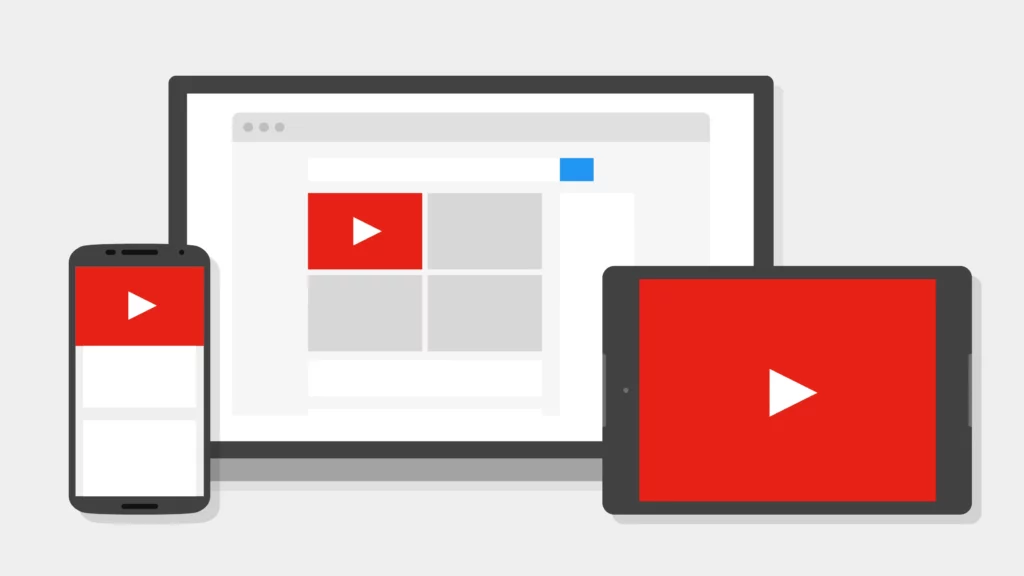
عند اختيار الحل ل كيفية إنشاء ترجمات باللغة الإنجليزية لليوتيوب, عادةً ما يهتم المبدعون بدرجة أقل بإمكانية إنجاز ذلك، وبدرجة أكبر بمدى استيفاء الترجمة لمتطلبات الاستخدام طويل الأمد ومتعدد المنصات. تُعد الأبعاد الرئيسية التالية معايير مهمة لتقييم جودة الأداة:
أ. الدقة
تعمل الترجمة التلقائية على يوتيوب بكفاءة جيدة عند وضوح الصوت. ومع ذلك، عند مواجهة لهجات أو محادثات متعددة الأشخاص أو ضوضاء في الخلفية، تنخفض الدقة بشكل ملحوظ. بالنسبة للمحتوى التعليمي أو التدريبي للشركات أو محتوى التجارة الإلكترونية العابر للحدود، تؤثر دقة الترجمة بشكل مباشر على نتائج التعلم وثقة المستخدم. في المقابل،, يمكن لـ Easysub تحسين دقة النسخ بشكل كبير من خلال نموذج التعرف على الكلام الأكثر تقدمًا ودعم قائمة المصطلحات, ، مما يقلل من عبء التدقيق اللغوي اليدوي اللاحق.
ب. التوافق
تتجاوز أهمية الترجمة يوتيوب. يرغب العديد من المبدعين في نشر فيديوهاتهم على منصات مثل تيك توك، وفيميو، ونظام إدارة التعلم (LMS)، أو منصات البث المحلية. لا يمكن تصدير الترجمة التلقائية لـ YouTube بتنسيقات قياسية (SRT/VTT) ولا يمكن استخدامه إلا داخل المنصة. ومع ذلك،, يدعم Easysub التصدير بنقرة واحدة للعديد من التنسيقات الشائعة, ، مما يتيح إعادة استخدام الترجمات عبر المنصات وتعزيز المرونة الإبداعية.
ج. الكفاءة
يمكن لمستخدمي الفيديوهات القصيرة تحمّل قدرٍ بسيط من التدقيق اللغوي اليدوي، لكن بالنسبة للفيديوهات الطويلة أو سلسلة الدورات التي تعتمد على التحرير اليدوي، سيستغرق ذلك وقتًا طويلًا. وخصوصًا للمؤسسات التعليمية أو فرق العمل، تُعد القدرة على معالجة كميات كبيرة أمرًا ضروريًا. يوفر Easysub وظائف إنشاء الدفعات والتعاون بين عدة أشخاص, ، مما يمكن أن يعزز الكفاءة بشكل كبير ويقلل تكاليف العمالة.
د. دعم متعدد اللغات
تقتصر ترجمات يوتيوب التلقائية في الغالب على اللغات الشائعة، وتفتقر إلى إمكانية الترجمة الآلية. ويتجلى هذا النقص بشكل خاص في التسويق عبر الحدود والدورات الدولية. يدعم Easysub إنشاء وترجمة الترجمات متعددة اللغات, ، مما يساعد المبدعين على توسيع قاعدة جمهورهم بسرعة وتحقيق التغطية العالمية.
في قطاعي التعليم والمؤسسات، هناك متطلبات محددة للترجمات، وخاصة معايير إمكانية الوصول (مثل WCAG). غالبًا ما تفشل الترجمات الآلية في تلبية هذه المعايير لأنها تفتقر إلى الاكتمال والدقة العالية. يوفر Easysub إمكانيات التعرف والتحرير الأكثر استقرارًا, ، مما يؤدي إلى إنشاء ملفات ترجمة تتوافق بشكل أفضل مع معايير الامتثال وتجنب المخاطر القانونية والمخاطر المتعلقة بالاستخدام.
التعليمات
س1: كيف يمكنني إنشاء ترجمات باللغة الإنجليزية على YouTube مجانًا؟
يمكنك إنشاء ترجمات باللغة الإنجليزية مجانًا من خلال استوديو يوتيوب. فقط قم بتحميل الفيديو الخاص بك، وانتقل إلى ترجمات عند استخدام هذه الوظيفة، اختر "الإنجليزية"، وسيُنشئ النظام مسارات الترجمة تلقائيًا. مع ذلك، يُرجى ملاحظة أن الترجمة المُولّدة غالبًا ما تتطلب تدقيقًا يدويًا، خاصةً عندما يحتوي الفيديو على لهجات أو ضوضاء في الخلفية.
س2: هل يمكنني تصدير التسميات التوضيحية التي تم إنشاؤها تلقائيًا في YouTube؟
لا. لا يمكن استخدام التسميات التوضيحية التلقائية التي يُنشئها يوتيوب إلا داخل المنصة. لا يمكن للمستخدمين قم بتنزيلها مباشرة كملفات SRT أو VTT. إذا كنت تريد تصدير ملفات الترجمة القياسية، فستحتاج إلى استخدام أداة خارجية أو برنامج ترجمة احترافي مثل إيزي ساب لتحقيق التصدير بنقرة واحدة.
س3: هل ترجمات YouTube التلقائية دقيقة بما يكفي للاستخدام الاحترافي؟
عادةً ما تكون الترجمة غير مستقرة. تعتمد دقة الترجمة التلقائية في يوتيوب على وضوح الكلام والبيئة اللغوية. في حالات اللهجات القوية، أو المحادثات المتعددة، أو الضوضاء العالية في الخلفية، يزداد معدل الخطأ بشكل ملحوظ. أما في حالة الفيديو التعليمي، أو التدريب المؤسسي، أو التجارة الإلكترونية العابرة للحدود، فستؤثر هذه الأخطاء على تجربة المستخدم واحترافيته. لضمان الاستخدام الاحترافي، يُنصح باستخدام وظيفة التعرف عالية الدقة التي يوفرها. إيزي ساب.
س4: ما الفرق بين ترجمات YouTube و Easysub؟
- ترجمات يوتيوب:مجاني، مناسب للتوليد السريع، لكن لا يمكن تصديره، مع دقة محدودة ودعم غير كافٍ لتعدد اللغات.
- إيزي سابخدمة مدفوعة، لكنها تتميز بمعدلات تعرف أعلى، وترجمة متعددة اللغات، وتصدير بنقرة واحدة، وإمكانية معالجة دفعات، وهي مناسبة للمبدعين المحترفين وفرق العمل في المؤسسات. بمعنى آخر، تُعد ترجمة يوتيوب حلاً للمبتدئين، بينما يُعد Easysub حلاً احترافيًا طويل الأمد.
س5: هل يمكن استخدام ترجمات Easysub على منصات أخرى؟
بالتأكيد. يدعم Easysub التصدير بتنسيقات الترجمة القياسية مثل SRT وVTT وASS. يمكن استخدام هذه الملفات على منصات وبرامج متعددة مثل VLC وQuickTime وTikTok وVimeo وأنظمة إدارة التعلم (LMS). مقارنةً بالترجمات المضمنة في YouTube والتي لا يمكن تطبيقها إلا داخل الموقع، يوفر Easysub توافقًا أقوى بين المنصات.
أنشئ ترجمات دقيقة باللغة الإنجليزية مع Easysub اليوم
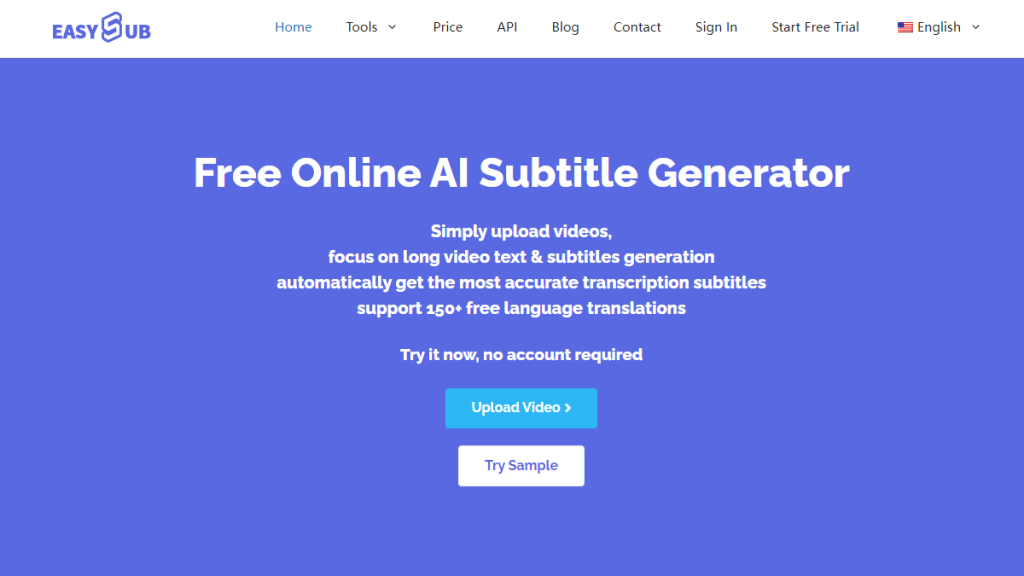
توفر ميزة الترجمة التلقائية على YouTube للمبدعين نقطة بداية مريحة، ولكنها الدقة والتوافق لقد كانت التكنولوجيا الرقمية تفتقر دائمًا إلى الكفاءة، وخاصة في مقاطع الفيديو الاحترافية، أو التدريب التعليمي، أو سيناريوهات التوزيع عبر الحدود حيث يكون أداؤها محدودًا.
لماذا تختار Easysub: تقدم Easysub دقة أعلى في التعرف، وترجمة متعددة اللغات، وتصدير بنقرة واحدة إلى التنسيقات القياسية (SRT/VTT/ASS), يدعم EasySub المعالجة الدفعية والتعاون الجماعي. سواءً كان الأمر يتعلق بمدونين فرديين أو مؤسسات تعليمية أو فرق عمل، يمكنهم الحصول بسرعة على ترجمات عالية الجودة عبر EasySub، مما يقلل من تكلفة التدقيق اللغوي اليدوي.
هل أنت مستعد لإنشاء ترجمات دقيقة باللغة الإنجليزية لفيديوهاتك على يوتيوب؟ جرّب Easysub مجانًا اليوم واحصل على الترجمات في دقائق.
👉 انقر هنا للحصول على نسخة تجريبية مجانية: easyssub.com
شكرا لقراءتك هذه المدونة. لا تتردد في الاتصال بنا لمزيد من الأسئلة أو احتياجات التخصيص!
